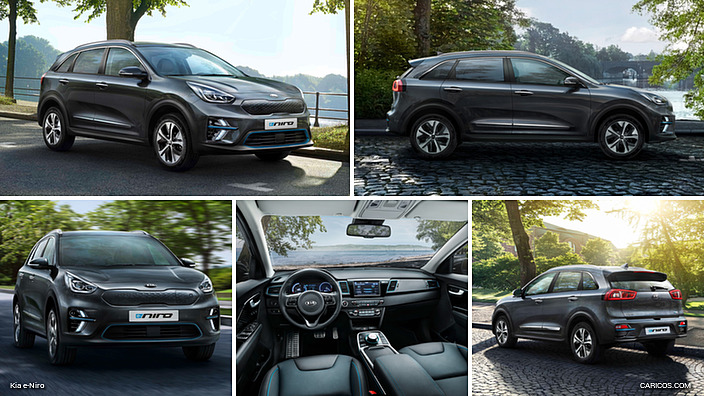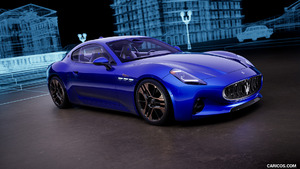2019 Kia e-Niro
- High-capacity 64 kWh lithium-ion polymer battery provides driving range of up to 301 miles on a single charge (WLTP combined cycle)
- Combines efficient electric power with crossover space and practicality
- Innovative technologies to harvest and conserve electric energy
- Comprehensive range of advanced driver assistance systems available
- Completes eco-friendly Niro crossover range, alongside Niro Hybrid and Plug-in Hybrid versions
- 200,000 Niro models sold globally since 2016; 65,000 sold in Europe
- On-sale in select European markets by the end of 2018
The all-new Kia e-Niro is the first fully electric crossover utility vehicle produced by Kia. With a range of 301 miles (485 kilometres) on the WLTP combined cycle, the all-electric e-Niro combines driving enjoyment, eye-catching design, crossover utility and a zero-emissions powertrain – to create one of the most capable electric vehicles on-sale worldwide.
The e-Niro occupies a unique position in the market as an all-electric crossover, with intelligent packaging, high practicality, and a long-distance driving range. Buyers will also benefit from a range of dedicated electric vehicle (EV) in-car technologies, new safety features, and stand-out exterior and interior design.
Emilio Herrera, Chief Operating Officer of Kia Motors Europe, commented: “A combination of cool crossover design and advanced powertrains led to more than 33,000 Niro sales across Europe in 2017, and more than 30,000 year-to-date in 2018, making it one of our best-selling models. Annual sales of electric vehicles across Europe are expected to reach 200,000 this year, rising to nearly one million units by the end of 2022, while the crossover market is also forecast to continue expanding in the coming years. The e-Niro is a clear demonstration of the progress Kia has made in delivering comfortable, practical and fun-to-drive vehicles that lead the way in zero-emissions driving.”
 2019 Kia e-Niro
2019 Kia e-Niro
The e-Niro joins existing Hybrid and Plug-in Hybrid variants of the car – of which more than 200,000 have sold globally since the Niro’s introduction in 2016. To date, Europe has accounted for more than 65,000 sales of the hybrid crossover.
The e-Niro is to be Kia’s second globally-sold electric vehicle after the Soul EV. The new model makes its European debut here at the 2018 Paris Motor Show, and will go on sale in select European markets by the end of 2018.
Futuristic design inspired by 2018 Niro EV Concept
Designed at Kia’s design centres in California, USA and Namyang, Korea, the e-Niro incorporates the practicality and appeal of a crossover in a sleek, aerodynamic body with subtly sculptured surfaces. The car demonstrates that, in seeking greater on-road efficiency, electric vehicle buyers need not sacrifice emotionally engaging design or crossover versatility.
The e-Niro differentiates itself from the existing Niro Hybrid and Niro Plug-in Hybrid with a series of exclusive design features. Taking inspiration from the Niro EV Concept unveiled at the 2018 Consumer Electronics Show in Las Vegas, the exterior is based on a ‘Clean and High-tech’ design concept. Its futuristic and aerodynamic ‘tiger-nose’ grille features an integrated charging port, bearing a de-bossed Niro logo. Redesigned air intakes and new arrowhead-shaped LED daytime running lights combine with blue trim highlights to help it stand out further.
The closed ‘tiger-nose’ grille design is housed within a newly designed front bumper, giving the car a clear family identity, while aiding aerodynamic performance, and providing a sleek and purposeful character to the front of the vehicle.
In profile, the slim character line, tapered rear windows and sturdy sill line help to emphasise and elongate the car’s sleek profile, while allowing greater room for the muscular wheel arches. The e-Niro rides on new 17-inch aluminium alloy wheels with a diamond-cut two-tone finish, housing Kia’s regenerative braking system.
At the back, redesigned rear bumpers feature similar blue trim highlights to those found at the front of the car. A bold LED rear light design gives the e-Niro the same distinct and recognisable rear light signature as its Hybrid and Plug-in Hybrid siblings.
The e-Niro is available in a selection of ten contemporary paint colours – a palette of bold or more neutral shades which emphasise the car’s eco-friendly design and complement the blue trim adorning its bodywork.
Modern interior with dedicated electric powertrain technologies and crossover utility
Inside the Kia e-Niro, the cabin combines a modern design with generous space and technologies that complement its zero-emissions powertrain. The interior is differentiated from other Niro models with a range of new features and design elements.
The design of the centre console represents the biggest change for the e-Niro, with the all-electric powertrain negating the need for a traditional gear stick and gear linkage. The physical transmission has therefore been replaced with a new ‘shift-by-wire’ rotator dial drive selector. The drive selector dial sits on its own highly-ergonomic panel which extends out from the base of the central arm-rest. In addition to the rotator dial, this new panel also houses buttons for the electronic parking brake, heated and ventilated seats, heated steering wheel, drive mode selector, parking sensors, and the Niro’s braking ‘Auto Hold’ function. The new panel requires no bulky transmission tunnel, enabling Kia’s designers to create a larger storage area at the base of the centre console.
The dashboard features bright blue trim around the vents, echoing the trim highlights found on the outside of the car. The cabin is trimmed in a choice of fabric and synthetic leather, full synthetic leather, or real leather. In each guise it is available in black or dark grey, or in a dedicated new e-Niro interior colour scheme with black upholstery and bright blue stitching, echoing the colour accents on the exterior of the car. For cars trimmed in leather and synthetic leather, the perforated upholstery features a vivid blue inlay, further complementing the blue details around the cabin and exterior of the car.
A new mood lighting system illuminates the centre console and shift dial with subtle lighting, in one of six colours – white, grey, bronze, red, green, and blue. New high-gloss black and blue trim also lines the doors of the e-Niro, further enhancing the futuristic atmosphere of the cabin. The shelf at the base of the instrument panel features a high-grip rubberised surface to hold the driver’s smartphone in place. Buyers can specify this shelf with an optional wireless smartphone charger.
The 7.0-inch touchscreen HMI (human-machine interface) in the centre of the dashboard offers a series of features specific to Kia’s new electric vehicle. It enables owners to locate nearby charging points, and monitor the level of remaining charge and range. It also lets owners gauge their trip and lifetime CO2 reduction from driving the e-Niro, compared to a petrol car of a similar size. The HMI lets owners set an approximate departure time for their next journey, enabling the car to heat itself to a set temperature before the driver departs. The charge management function also intelligently manages the flow of electricity to the battery when charging, to help extend the life of the battery.
The colour-LCD driver instrument cluster – also 7.0-inches wide – shows driving and battery charge information on-the-move. The display also gauges the driving style of whoever is sitting at the wheel, attributing a percentage to the amount of ‘economical’ driving they manage on each journey. For drivers preferring to enjoy the car’s low centre of gravity and instant off-the-line acceleration, the display also shows what percentage of a journey has been completed with ‘dynamic’ driving.
A lamp is integrated into the top of the dashboard, with a light displaying whether the battery pack is recharging or fully charged when plugged in. This enables owners to quickly see the car’s charging status at a glance when charging.
When the Niro was first launched in 2016, its new platform was engineered to accommodate a variety of advanced powertrains. The introduction of a battery-electric powertrain has had minimal impact on packaging and versatility, meaning the e-Niro offers greater practicality and versatility by design than many other electric and hybrid cars. Its 2,700 mm wheelbase ensures all occupants enjoy generous legroom, while space and a sense of roominess is boosted by its crossover design. Its body is 1,805 mm wide and 1,560 mm tall, ensuring maximum head- and shoulder-room throughout the cabin. At 4,375 mm in length, it offers more cargo space – 451 litres (VDA) – than many other plug-in and electric vehicles. The boot features a dedicated storage area beneath its floor, providing space for owners to store the charging cable.
301 mile driving range from next-generation all-electric powertrain
The Kia e-Niro has been designed to merge crossover-inspired design with long-distance, zero-emissions driving and enjoyable performance. It achieves this with a next-generation electric powertrain, using new production technologies developed specifically for Kia electric vehicles.
The e-Niro offers buyers a convincing alternative to compact crossovers powered by traditional petrol or diesel internal combustion engines. It gives owners the opportunity to complete both long distance drives and daily commutes with zero emissions and ultra-low running costs.
In Europe the Niro will be equipped with a high-capacity 64 kWh lithium-ion polymer battery pack. On the WLTP combined cycle, it provides a driving range of more than 301 miles (485 kilometres) on a single charge, producing zero on-road CO2 emissions. On the WLTP urban cycle, the e-Niro is capable of driving up to 382 miles (615 km). Buyers will also be to specify their e-Niro with a 39.2 kWh lithium-ion polymer battery pack, with a range of up to 193 miles (312 kilometres) from a single charge on the WLTP combined cycle. Plugged into a 100 kW fast charger, it takes only 42 minutes to recharge the e-Niro’s battery from 20% to 80%.
Models equipped with the long-distance 64 kWh battery pack are paired with a 150 kW (204 ps) motor, producing 395 Nm torque, enabling the e-Niro to accelerate from 0-to-100 kph in just 7.8 seconds. The standard 39.2 kWh battery pack is matched to a 100 kW (136 ps) motor, also producing 395 Nm torque, and accelerating to 100 kph from a standstill in 9.8 seconds. Like the Niro Hybrid and Plug-in Hybrid variants, the new electric model is front-wheel drive.
Energy-harvesting and predictive driving assistant technologies
The e-Niro provides owners with a range of technologies to enhance battery efficiency and improve the car’s range.
Regenerative braking technology allows the Niro to harvest kinetic energy and recharge the battery pack while coasting or braking, while the Eco Driving Assistant System (Eco DAS) provides drivers with intelligent guidance on how to drive more efficiently. Eco DAS includes Coasting Guide Control (CGC) and Predictive Energy Control (PEC), enabling drivers to maximise vehicle range by suggesting when to coast or brake.
CGC alerts drivers as to the best time to lift off the accelerator and coast towards a junction, allowing the battery to regenerate under engine deceleration. Operating at certain speeds when a navigation destination is set, the system alerts drivers when to coast via a small icon in the instrument cluster as well as an unobtrusive audible warning.
While the electric motor requires no transmission, the car still features a pair of metal paddles behind the steering wheel. These paddles let drivers choose between three levels of energy recuperation. The higher the level of recuperation chosen by the driver, the more energy the regenerative brakes try to harvest.
The Niro’s Electric Parking Brake (EPB), is operated by a button on the new centre console panel. The driver can manually apply the parking brake once stopped. When moving off, the EPB switches off automatically, allowing a seamless start.
A battery heating system is also fitted to the e-Niro, designed to insulate and warm up the battery while the vehicle is plugged in, minimising the adverse effects of cold temperatures.
The e-Niro is also fitted with an advanced heat pump, which draws on heat energy from the air-conditioning and electrical systems. Instead of relying entirely on battery power to heat the cabin, the heat pump recycles this heat energy to improve the efficiency of the car’s heating, ventilation and air-conditioning (HVAC) system. The system is made up of a compressor, evaporator and condenser, which improve the car’s ability to efficiently heat up the cabin, minimising electricity consumption from the battery. In turn, this increases the e-Niro’s overall driving range.
The e-Niro is also equipped with a Drive Mode Select system, enabling owners to tailor their driving experience. Switching between Normal, Eco and Sport modes, Drive Mode Select alters the level of effort required to steer the car, and subtly changes the character of the powertrain. Eco mode maximises the potential for greater fuel efficiency by limiting the maximum torque and power of the motor, softening throttle responses, and offering more relaxed steering inputs. Normal mode is the most suitable for day-to-day driving, combining the innate efficiency and performance of the powertrain with direct steering and throttle responses. Sport mode enhances throttle responses and enables maximum acceleration, as well as weighting up the steering for more decisive responses to driver inputs, bringing the e-Niro’s engaging handling character to the fore.
Low centre of gravity with fully-independent suspension for stable ride and handling
The Kia Niro was engineered from the start to accommodate a specific range of hybrid and fully-electric powertrains. The Niro’s ride and handling therefore was always readily adaptable to the introduction of an all-electric powertrain.
The battery pack is located low down in the body, between the two axles, giving the crossover a centre of gravity more akin to that of a sedan or a hatchback. With a relatively wide stance, the e-Niro offers drivers maximum stability and driving enjoyment on winding roads, and minimal body roll under cornering. The car is equipped with fully independent rear suspension, tuned to deliver high stability and immediate handling responses and filter out small vibrations at higher speeds when travelling over poor surfaces.
The e-Niro’s regenerative brakes – 305 mm in diameter at the front, 300 mm at the rear – exhibit a consistent, linear deceleration and braking feel, and harvest kinetic energy to recharge the battery pack on the move.
The e-Niro is refined and quiet at low speeds thanks to its all-electric powertrain. The e-Niro boasts an even lower drag co-efficient (0.29 Cd) than Niro Hybrid and Plug-in Hybrid models (0.30 Cd), suppressing wind noise and enhancing its aerodynamic efficiency. This is aided by laminated windscreen glass, a cowl over the front windscreen wipers, specially-profiled door mirror casings and covers over the holes in the roof rails – which sit flush on the bodywork. Road noise is minimised further by high-insulation rigid bushes in the front subframe, high-strength steel in the rear wheel arches, to reduce high frequency vibrations around the rear of the car and additional sound insulation material in the A- and B-pillars.
Advanced Driver Assistance Systems
Matching the next-generation nature of its powertrain, the e-Niro offers drivers a range of Kia’s Advanced Driver Assistance Systems, supporting motorists in a range of driving conditions and scenarios to mitigate the risk of collisions.
The car is equipped, as standard, with Kia Vehicle Stability Management (VSM) for maximum stability under braking and cornering. If VSM detects a loss of traction, it uses the car’s Electronic Stability Control (ESC) system and the electric motor-driven power steering to help the driver retain control.
Other active safety systems available in the e-Niro include Forward Collision Warning with Forward Collision-Avoidance Assist, Smart Cruise Control with Stop & Go, High Beam Assist, Driver Attention Warning, and Lane Following Assist. Lane Following Assist tracks vehicles in front of the car in traffic, and detects road markings to keep the e-Niro in its lane on the motorway. The system controls acceleration, braking and steering depending on the convoy of vehicles in front, using external sensors to maintain a safe distance. Lane Following Assist operates between 0 and 130 kph.
European sales start later in 2018 with a 7-Year, 100,000-mile warranty
The new Kia e-Niro will enter production in Q2 2018 at Kia’s Hwasung manufacturing facility in Korea. On sale in select European markets by the end of 2018, the e-Niro will be covered by Kia’s quality promise, with the brand’s industry-leading 7-Year, 100,000-mile warranty as standard. The warranty also covers the battery pack and electric motor.
Full UK specification, pricing and on-sale date will be announced in due course.









